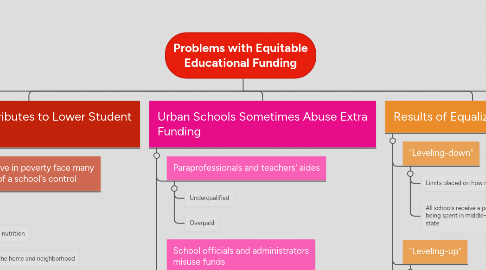
1. Missing Connection between School Finances and Academic Achievement
1.1. Studies Show More Money Does Not Equal Higher Achievement
1.1.1. District of Columbia Schools
1.1.2. State of Nevada
1.1.3. Nationwide spending per-pupil has increased, while student achievement is hovering at the same level, or even decreasing
2. Urban Schools Sometimes Abuse Extra Funding
2.1. Paraprofessionals and teachers' aides
2.1.1. Underqualified
2.1.2. Overpaid
2.2. School officials and administrators misuse funds
2.2.1. Private use
2.2.2. Spending is unjustified and not directed towards student achievement
3. Success in a School Should Not be Dependent on Funding
3.1. Skilled Teachers
3.1.1. Also provide emotional support
3.1.2. Provide differentiated instruction
3.2. Quality Curriculum
3.2.1. Curriculum which helps students be prepared for life outside of school
3.2.2. Teach the required standards
3.3. Transparent Spending
3.3.1. Have the trust and support of the tax payers in your community
3.4. Support of the Community
3.4.1. Collaborative Effort
4. Poverty Contributes to Lower Student Success
4.1. Children who live in poverty face many obstacles out of a school's control
4.1.1. Move often
4.1.2. Poor health and nutrition
4.1.3. Distractions in the home and neighborhood
4.1.4. Crowded home life
4.1.5. Lack of support, resources, and aide from parents
5. Results of Equalizing Funding
5.1. "Leveling-down"
5.1.1. Limits placed on how much a school can spend
5.1.2. All schools receive a per-pupil amount equivalent to that being spent in middle-class or poorer districts in the state
5.2. "Leveling-up"
5.2.1. Requires an increase in taxes across a state
5.2.1.1. People pay higher taxes, but only a few see increased services to their communities
5.2.2. The state funds all schools at the same per-pupil rate as the wealthiest districts
5.3. Tax Payers Lose the Freedom to Choose
5.3.1. Decreases in local support
5.3.2. Loss of local control
